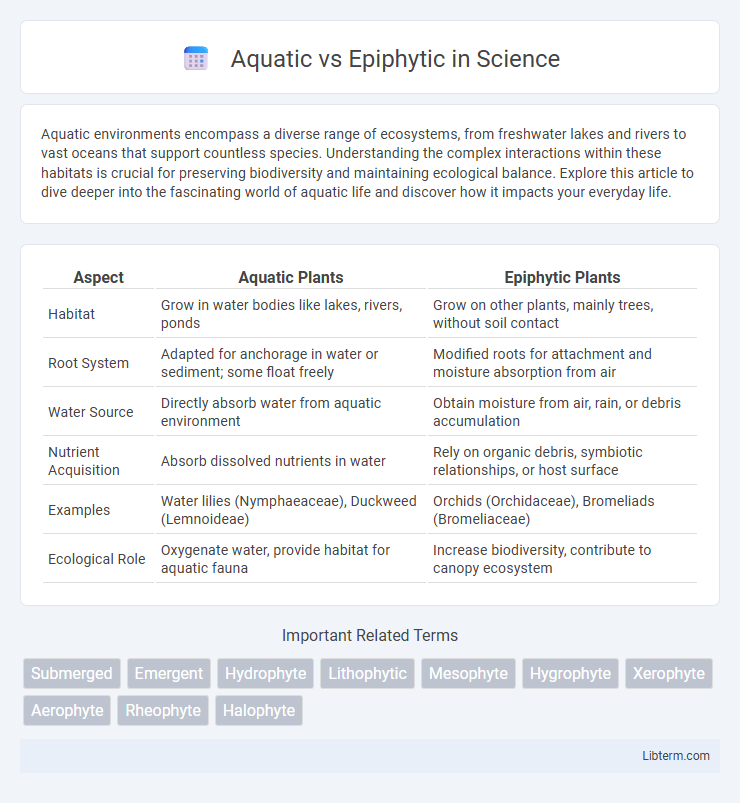Aquatic environments encompass a diverse range of ecosystems, from freshwater lakes and rivers to vast oceans that support countless species. Understanding the complex interactions within these habitats is crucial for preserving biodiversity and maintaining ecological balance. Explore this article to dive deeper into the fascinating world of aquatic life and discover how it impacts your everyday life.
Table of Comparison
| Aspect | Aquatic Plants | Epiphytic Plants |
|---|---|---|
| Habitat | Grow in water bodies like lakes, rivers, ponds | Grow on other plants, mainly trees, without soil contact |
| Root System | Adapted for anchorage in water or sediment; some float freely | Modified roots for attachment and moisture absorption from air |
| Water Source | Directly absorb water from aquatic environment | Obtain moisture from air, rain, or debris accumulation |
| Nutrient Acquisition | Absorb dissolved nutrients in water | Rely on organic debris, symbiotic relationships, or host surface |
| Examples | Water lilies (Nymphaeaceae), Duckweed (Lemnoideae) | Orchids (Orchidaceae), Bromeliads (Bromeliaceae) |
| Ecological Role | Oxygenate water, provide habitat for aquatic fauna | Increase biodiversity, contribute to canopy ecosystem |
Introduction to Aquatic and Epiphytic Plants
Aquatic plants thrive in water environments such as ponds, lakes, and wetlands, exhibiting adaptations like buoyant leaves and specialized root systems to absorb nutrients directly from the water. Epiphytic plants grow non-parasitically on other plants, primarily trees, deriving moisture and nutrients from the air, rain, and debris, with common examples including orchids and bromeliads. These distinct growth habits illustrate adaptive strategies for survival in aquatic versus aerial habitats, influencing their morphology and ecological roles.
Defining Aquatic Plants
Aquatic plants are specialized organisms adapted to grow in water environments, either fully submerged or floating on the surface, with structures designed for oxygen absorption and nutrient uptake in aquatic habitats. These plants exhibit features such as flexible stems, air-filled tissues, and root systems anchored in sediment or free-floating. Epiphytic plants, in contrast, grow non-parasitically on other plants, relying on the host merely for physical support while obtaining moisture and nutrients from the air, rain, or debris.
Defining Epiphytic Plants
Epiphytic plants grow non-parasitically on other plants, using them for physical support while obtaining moisture and nutrients from the air, rain, and debris. Unlike aquatic plants, which thrive submerged or floating in water environments, epiphytes are primarily adapted to terrestrial ecosystems, often found in tropical rainforests. This unique adaptation allows epiphytic plants to exploit light and space above the forest floor without disturbing the host plant's vascular system.
Key Differences Between Aquatic and Epiphytic Species
Aquatic species thrive in water environments, absorbing nutrients directly from their surroundings through submerged roots or leaves, while epiphytic species grow on other plants, obtaining moisture and nutrients from the air and debris without harming their hosts. Aquatic plants often have flexible stems and specialized tissues like aerenchyma to facilitate gas exchange underwater, whereas epiphytes possess adaptations such as waxy cuticles and trichomes to retain moisture in aerial habitats. The distinct ecological niches of aquatic and epiphytic species influence their root structures, nutrient acquisition methods, and physical adaptations for survival in water or on host plants.
Adaptations of Aquatic Plants
Aquatic plants exhibit specialized adaptations such as aerenchyma tissues for buoyancy and oxygen transport, flexible stems to withstand water currents, and submerged or floating leaves with reduced cuticles for efficient gas exchange. Their root systems are often reduced or modified to absorb nutrients directly from the water, contrasting with epiphytic plants that rely on aerial roots to gather moisture from the air. These physiological and structural traits enable aquatic plants to thrive in water-saturated environments, optimizing survival and growth.
Adaptations of Epiphytic Plants
Epiphytic plants develop specialized adaptations such as aerial roots covered with velamen to absorb moisture and nutrients from the air, enabling survival without soil. Their leaves often have waxy coatings and trichomes to reduce water loss and capture dew, while some form symbiotic relationships with fungi for enhanced nutrient uptake. These adaptations allow epiphytes to thrive in canopy environments, contrasting with aquatic plants that rely on water-submersion adaptations like air-filled tissues for buoyancy.
Habitat and Distribution Comparison
Aquatic plants thrive in freshwater or marine environments, flourishing in ponds, lakes, rivers, and wetlands with submerged or floating structures adapted for water absorption. Epiphytic plants grow on other plants, mainly trees, in tropical and subtropical forests, accessing moisture and nutrients from the air, rain, and debris, not soil. Aquatic species are distributed globally in water bodies, while epiphytes are concentrated in humid, forested regions with high biodiversity, such as rainforests in the Amazon, Southeast Asia, and Central America.
Ecological Roles in Their Respective Environments
Aquatic plants play a crucial role in freshwater ecosystems by oxygenating water, providing habitat for fish and invertebrates, and filtering pollutants to maintain water quality. Epiphytic plants contribute to forest biodiversity by creating microhabitats on tree surfaces, capturing nutrients from rainwater and organic debris, and supporting various insect and bird species. Both plant types enhance ecosystem stability through their specialized adaptations to aquatic and aerial environments.
Challenges in Cultivating Aquatic vs Epiphytic Plants
Cultivating aquatic plants requires maintaining stable water quality, controlling algae growth, and ensuring adequate oxygenation to prevent root rot and nutrient deficiencies. Epiphytic plants pose challenges such as securing proper air circulation, providing consistent humidity levels, and supplying nutrients without soil, often relying on specialized growing mediums or periodic misting. Both plant types demand careful environmental adjustments to mimic their natural habitats and optimize growth conditions.
Choosing Between Aquatic and Epiphytic for Your Needs
Choosing between aquatic and epiphytic plants depends on your environment and maintenance preferences. Aquatic plants thrive submerged or floating in water, ideal for ponds and aquariums that require oxygenation and water filtration. Epiphytic plants grow on other surfaces without soil, suited for indoor spaces needing low-maintenance greenery with filtered light and good air circulation.
Aquatic Infographic

 libterm.com
libterm.com